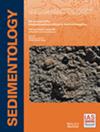Authigenic-cemented pebbles formed during Pleisto–Holocene transgression of gently inclined coastal plains
IF 2.8
2区 地球科学
Q1 GEOLOGY
引用次数: 0
Abstract
From numerous modern gently inclined coastal areas and deltas around the world carbonate-cemented sandstone slabs and pebbles have been reported. Such sandstones collected at the coast of the German North Sea and the Mediterranean Sea (Rhône Delta) are cemented by calcite derived from the anaerobic oxidation of methane, as evidenced by biomarkers and δ13C isotope values <−35‰ typical of anaerobic oxidation of methane. The methane originated from peat, which formed in coastal lowlands, deltas and channels during the Pleisto–Holocene transgression due to the concomitant rise of the groundwater level. During ongoing transgression, the peat became overlain by marginal-marine mud, acting as a seal, and finally by marine sand. In shallow-marine settings, wave-pumping effects during storms led to seal failure and methane could migrate upward. This scenario matches recent observations in the German North Sea where a pockmark field formed during the winter storm season. The emanating methane was eventually oxidized aerobically or anaerobically by anaerobic oxidation of methane in the sand cover. The CH4 generated in the peat underneath contains ‘old’ carbon that becomes, in the case of anaerobic oxidation of methane, incorporated into bicarbonate, which in turn facilitates cementation of sand and, thus, causes the peculiar situation that the C-14 age of the cement is older than the bioclasts embedded in the sandstone. Such authigenically cemented sandstones have environmental significance for flooding of gently inclined coastal plains.缓倾斜海岸平原更新世-全新世海侵期间形成的自生胶结卵石
在世界各地的许多现代缓倾斜沿海地区和三角洲,已经报道了碳酸盐岩胶结砂岩板和鹅卵石。在德国北海和地中海海岸(Rhône三角洲)采集的此类砂岩,其生物标志物和甲烷厌氧氧化的典型δ13C同位素值<−35‰证明了这些砂岩是由甲烷厌氧氧化产生的方解石胶结的。甲烷来源于泥炭,泥炭是更新世—全新世海侵期间,由于地下水水位上升而形成的沿海低地、三角洲和河道。在持续的海侵过程中,泥炭被边缘海相泥覆盖,起到封印的作用,最后被海相沙覆盖。在浅海环境中,风暴期间的波浪泵送效应导致密封失效,甲烷可能向上迁移。这种情况与最近在德国北海的观测结果相吻合,那里在冬季风暴季节形成了一个麻子区。排放出的甲烷最终通过对沙层甲烷的厌氧氧化进行好氧或厌氧氧化。下面泥炭中产生的CH4含有“老”碳,在甲烷厌氧氧化的情况下,这些碳被合并到碳酸氢盐中,这反过来又促进了沙子的胶结,从而导致了水泥的C-14年龄比嵌入砂岩中的生物碎屑更老的特殊情况。这种自生胶结砂岩对缓倾斜海岸平原的水淹具有环境意义。
本文章由计算机程序翻译,如有差异,请以英文原文为准。
求助全文
约1分钟内获得全文
求助全文
来源期刊

Sedimentology
地学-地质学
CiteScore
8.20
自引率
11.40%
发文量
94
审稿时长
6-12 weeks
期刊介绍:
The international leader in its field, Sedimentology publishes ground-breaking research from across the spectrum of sedimentology, sedimentary geology and sedimentary geochemistry.
Areas covered include: experimental and theoretical grain transport; sediment fluxes; modern and ancient sedimentary environments; sequence stratigraphy sediment-organism interaction; palaeosoils; diagenesis; stable isotope geochemistry; environmental sedimentology
 求助内容:
求助内容: 应助结果提醒方式:
应助结果提醒方式:


